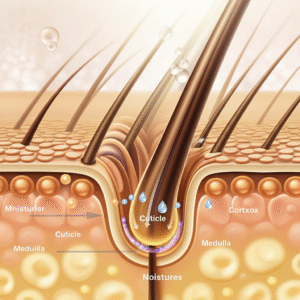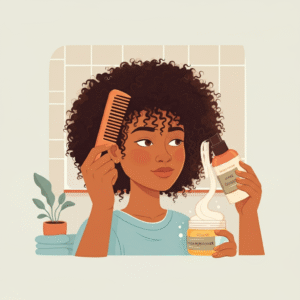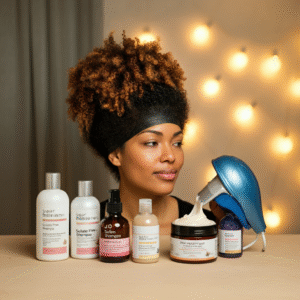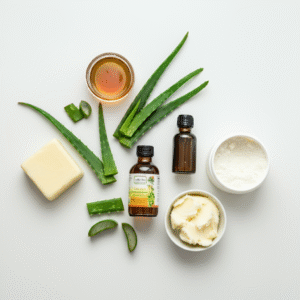
Introduction
If your hair gets frizzy, dries in the blink of an eye after washing, and seems to tangle into knots just by looking at it, you are likely dealing with high porosity hair. This hair type can be frustrating, as it often feels like a constant battle against dryness and breakage, no matter how many products you use. Understanding your hair’s porosity is the first and most crucial step toward achieving healthy, manageable locks. It’s the key to unlocking a routine that works with your hair, not against it, helping you improve moisture retention and prevent the endless cycle of frizz and damage.
High porosity hair isn’t a life sentence to bad hair days. It simply means your hair has unique needs. The outer layer of your hair, the cuticle, has gaps and holes that allow moisture to enter easily but also escape just as quickly. This is why your hair might feel moisturized one minute and dry the next. The solution lies in a targeted approach that focuses on repairing the damaged hair cuticle, deeply hydrating the strands, and sealing in that precious moisture. This guide will provide you with comprehensive high porosity hair solutions, from identifying your hair type to building a daily, weekly, and monthly hair care routine that will help you repair, moisturize, and strengthen your hair naturally.

What is High Porosity Hair?
To truly understand how to care for high porosity hair, we need to look at the science behind a single hair strand. Each strand is composed of three layers: the medulla (the innermost part), the cortex (the middle layer containing fibrous proteins and pigment), and the cuticle (the protective outer layer). Imagine the cuticle as overlapping shingles on a roof. In healthy, low-porosity hair, these “shingles” lie flat and tight, creating a smooth surface that effectively locks in moisture.
In high porosity hair, these cuticles are raised, open, or even have gaps and holes along the shaft. This compromised structure is often described as having damaged cuticle layers. Because of these openings, water and hair products can penetrate the hair shaft with ease. While that might sound like a good thing, the problem is that these same openings allow moisture to escape just as rapidly. This constant, quick loss of moisture leaves the hair dehydrated, fragile, and vulnerable to damage.
Key Signs of High Porosity Hair:
- Hair Dries Very Quickly: After washing, your hair might feel dry to the touch in under an hour, much faster than other hair types.
- Looks and Feels Dry and Brittle: Even after applying moisturizing products, the hair can feel coarse or straw-like.
- Excessive Frizz and Tangling: The raised cuticles on different strands catch on each other, leading to tangles, knots, and a frizzy appearance.
- Prone to Breakage and Split Ends: The weak, dry structure makes the hair more susceptible to snapping and splitting, hindering length retention.
- Absorbs Products Instantly: When you apply products like creams or oils, your hair seems to drink them up immediately, but it doesn’t stay moisturized for long.
- Lacks Shine: The rough, uneven cuticle surface doesn’t reflect light well, resulting in hair that looks dull rather than glossy.
Understanding these signs is the first step toward finding effective high porosity hair solutions. Your hair isn’t “bad”; it’s simply crying out for a different kind of care to manage its unique structure.
Causes of High Porosity Hair
While some people are naturally born with high porosity hair due to their genetics, it is more commonly a result of damage that lifts and breaks down the hair’s cuticle layer over time. Identifying the cause can be a critical part of learning how to fix high porosity hair because it allows you to eliminate damaging practices from your routine.
Natural Causes:
Genetics play a significant role in determining your hair’s inherent structure. For some, high porosity is simply the hair they were born with. Certain hair types, particularly curly and coily textures (like Type 3 and Type 4 hair), are naturally more prone to having a higher porosity. The bends and curves in these hair patterns can cause the cuticle scales to lift slightly, creating a more porous strand from the start.
External Damage:
More often than not, high porosity is caused or worsened by external factors that inflict wear and tear on the hair shaft.
- Heat Styling: Frequent use of blow dryers, flat irons, and curling wands at high temperatures can essentially “cook” the hair’s protein structure. This intense heat can permanently damage and lift the cuticle, creating the gaps characteristic of high porosity. This is a common form of heat damage hair.
- Chemical Treatments: This is one of the biggest culprits. Bleaching, coloring, chemical relaxing, and perming all work by chemically altering the hair’s structure. These processes force the cuticle to swell and open to allow the chemicals to penetrate the cortex. Over time, and especially with repeated treatments, the cuticle can become permanently raised and damaged, leading to severe chemical hair damage.
- Environmental Factors: Your surroundings can also take a toll on your hair’s health. Prolonged sun exposure can degrade the hair’s protein and lipids, while humidity can cause highly porous hair to swell with moisture and then become frizzy. Even environmental pollution and hard water minerals can build up on the hair, contributing to dryness and damage.
- Mechanical Damage: Rough handling of your hair can cause physical damage to the cuticle. This includes aggressive brushing, detangling dry hair, using harsh towel drying methods, and wearing tight hairstyles that pull on the strands.
By understanding these causes, you can begin to build a high porosity hair care routine that not only treats the symptoms but also prevents further damage.
How to Test if You Have High Porosity Hair
If the signs and symptoms sound familiar, you can confirm your hair’s porosity with a few simple, at-home tests. These DIY hair tests are easy to perform and will give you a clear indication of how your hair interacts with water, which is the core of understanding porosity.
The Float Test (Step-by-Step):
The float test is the most popular and straightforward hair porosity test.
- Get a Clean Hair Strand: First, make sure your hair is clean and free of any products. Wash and rinse your hair thoroughly, and let it air dry completely without adding any leave-in conditioners or oils. Pluck a single strand that has shed naturally (you can usually find one in your comb or brush).
- Prepare the Water: Fill a clear glass or bowl with room-temperature water.
- Place the Hair in Water: Gently place the clean, dry hair strand on the surface of the water.
- Observe: Watch the strand for a few minutes to see what it does.
- If it sinks quickly to the bottom: You have high porosity hair. The gaps in the cuticle allow water to rush in, weighing the strand down and causing it to sink fast.
- If it floats for a while before slowly sinking: You have medium or “normal” porosity hair. The cuticle is healthy and allows moisture in at a steady rate.
- If it remains floating at the top: You have low porosity hair. The tightly bound cuticle resists water absorption.
Other Simple Tests:
- The Slip Test: Gently slide your thumb and index finger up a single strand of hair, from the tip towards the scalp. If the strand feels bumpy or rough, it indicates that your cuticles are open and raised, which is a sign of high porosity. A smooth journey up the strand suggests low porosity.
- The Spray Bottle Test: Take a small section of your dry, clean hair and mist it with a spray bottle of water. Watch how your hair reacts. If the water beads up on the surface, you likely have low porosity hair. If your hair absorbs the water almost instantly, you have high porosity hair.
Performing these tests will give you the confidence to move forward with a targeted high porosity hair routine, ensuring you choose the right products and techniques to restore your hair’s health.
Common Problems with High Porosity Hair
The unique structure of high porosity hair leads to a specific set of challenges. Because the hair cuticle is open, it creates a cycle of problems that can be difficult to manage without the right solutions. Understanding these issues is key to selecting the best products for high porosity hair and developing an effective care regimen.

1. Lack of Moisture Retention
This is the root of all evil for high porosity hair. While the hair can easily absorb water and moisturizing products, it cannot hold onto them. The gaps in the cuticle allow moisture to evaporate into the air almost as quickly as it was applied. This leads to chronic dryness and dehydration, making the hair feel perpetually thirsty. It’s a frustrating cycle where you apply product, your hair feels good for a short time, and then it’s back to being dry and brittle.
2. Excessive Frizz and Tangling
Frizz is a direct result of the raised cuticles. In humid conditions, the open cuticles absorb excess moisture from the air, causing the hair shaft to swell and create a frizzy halo. The raised, rough texture of individual strands also acts like Velcro, causing them to snag and tangle with neighboring hairs. This makes detangling a difficult and often painful process that can lead to further breakage. Effective frizz control techniques are a must-have in any high porosity hair care plan.
3. Hair Breakage and Split Ends
High porosity hair is inherently weak. The gaps in the cuticle compromise the structural integrity of the hair strand, making it fragile and highly susceptible to breakage. Simple acts like combing, styling, or even sleeping can cause the hair to snap. This constant breakage can make it seem like your hair isn’t growing, even when it is. Furthermore, the dryness contributes to split ends, where the ends of the hair shaft fray and unravel, requiring regular trims to prevent the damage from traveling further up the strand.
4. Increased Product Absorption and Buildup
Because high porosity hair absorbs everything so quickly, it’s easy to over-apply products in an attempt to keep it moisturized. This can lead to product buildup, especially if you’re using heavy butters and oils frequently. When products build up on the hair and scalp, they can clog follicles, weigh the hair down, and paradoxically prevent moisture from getting in. This makes the hair look dull, limp, and greasy, even when it feels dry. A good damaged hair care routine for porous hair must include methods for clarifying and removing this buildup.
Step-by-Step High Porosity Hair Care Routine
Creating a consistent and targeted hair care routine is the most effective way to manage high porosity hair. The goal is three-fold: infuse moisture, strengthen the cuticle, and seal it all in. Here is a sample daily, weekly, and monthly routine designed for repairing high porosity hair.

1. Daily Routine
The focus of your daily care should be on maintaining moisture and minimizing manipulation.
- Gentle Detangling: If you must detangle daily, do it gently. Use your fingers or a very wide-tooth comb. Never try to rip through knots, especially when your hair is dry. Lightly misting your hair with water or a leave-in conditioner first can provide slip and reduce breakage.
- Moisturize and Seal: High porosity hair loses moisture throughout the day and night. Refresh your hair daily by applying a lightweight moisturizer or a water-based leave-in conditioner for frizz control. Immediately follow this with a moisture sealant. This involves applying a heavier oil or butter (like shea butter or castor oil) to the ends and length of your hair. This creates a protective barrier that locks the moisture in.
2. Weekly Routine
Your weekly “wash day” is your opportunity for deep repair and hydration.
- Cleansing: Avoid harsh shampoos with sulfates, as they can strip your hair of its natural oils and worsen dryness. Opt for a sulfate-free moisturizing shampoo or try co-washing—washing your hair only with a cleansing conditioner. This co-washing routine is gentler and helps preserve moisture.
- Deep Conditioning: This is non-negotiable for high porosity hair. After cleansing, apply a rich deep conditioning hair mask. For maximum absorption, use gentle heat. You can sit under a hooded dryer, use a thermal heat cap, or simply cover your hair with a plastic cap and wrap a warm towel around it for 20-30 minutes. The heat helps the nourishing ingredients penetrate deeper into the hair shaft.
- Clarifying (As Needed): If you use a lot of heavy products, your hair may benefit from a clarifying shampoo once or twice a month to remove buildup. Follow up immediately with a deep conditioner to restore moisture.
3. Monthly Routine
Monthly treatments should focus on structural repair and maintenance.
- Protein Treatment: Protein treatments are essential for strengthening high porosity hair. They work by temporarily filling in the gaps and holes in the damaged cuticle, which reinforces the hair strand. A protein treatment for hair can make your hair feel stronger and more resilient. Do this once every 4-6 weeks. Be careful not to overdo it, as too much protein can make the hair stiff and brittle.
- Trim Split Ends: Regularly trim your hair to remove split ends. Even a small trim (about a quarter to a half-inch) every 2-3 months can prevent splits from traveling up the hair shaft and causing more significant breakage. This is a crucial step for split ends repair and retaining length.
This structured routine provides a powerful framework for high porosity hair solutions, helping you build a foundation for healthier, stronger hair.
Best Ingredients & Products for High Porosity Hair
Choosing the right products is half the battle when it comes to high porosity hair. Your hair needs a thoughtful combination of ingredients that hydrate, strengthen, and seal. Look for products that feature these key components.

Hydrating Ingredients (Humectants):
These ingredients attract water from the air and draw it into the hair shaft. They provide the initial burst of moisture your hair desperately needs.
- Aloe Vera: A natural humectant that is packed with vitamins and minerals.
- Honey: Another powerful natural humectant that also has antibacterial properties.
- Glycerin: A very effective moisture-attracting ingredient found in many hair products.
- Panthenol (Pro-Vitamin B5): Penetrates the hair shaft to provide hydration and adds shine.
Moisture-Sealing Oils and Butters (Emollients):
These heavier ingredients are crucial. They don’t moisturize on their own, but they create a protective layer over the hair cuticle to lock in the water-based products you’ve applied.
- Shea Butter: A rich butter that is excellent for sealing thick or coily hair.
- Castor Oil: A thick, viscous oil (especially Jamaican Black Castor Oil) known for sealing moisture and promoting scalp health.
- Olive Oil: A classic, accessible oil that helps to coat the hair shaft and reduce moisture loss.
- Avocado Oil & Jojoba Oil: These oils are closer in composition to our scalp’s natural sebum and are great for sealing without being overly greasy.
Protein-Rich Ingredients:
These ingredients provide the building blocks needed for repairing high porosity hair. They patch up the holes in the cuticle, improving strength and elasticity.
- Hydrolyzed Proteins (Keratin, Silk, Wheat): “Hydrolyzed” means the protein molecules have been broken down into smaller sizes, allowing them to penetrate the hair shaft and bond to the damaged areas.
- Amino Acids: The individual building blocks of protein that help fortify the hair structure from within.
Product Recommendations:
When shopping, look for product lines specifically formulated for dry, damaged, or high porosity hair.
- Best Shampoo for High Porosity Hair: Look for sulfate-free, moisturizing formulas that contain ingredients like aloe vera or glycerin. Co-washes (cleansing conditioners) are also an excellent choice for regular use.
- Best Conditioner: Your rinse-out conditioner should be thick and rich. A protein-rich conditioner can help provide a dose of strength with every wash.
- Best Deep Conditioner/Masque: Choose a mask that contains a balance of moisturizing butters (like shea or mango) and strengthening proteins. Products labeled as “repairing” or “restorative” are often a good fit.
- Best Leave-In Conditioner & Styler: A creamy, water-based leave-in is perfect for daily hydration. Follow it with a styling gel or cream that contains moisture-sealing oils to help define your style while locking in moisture.
By learning to read ingredient labels and understanding what your hair needs, you can curate a product arsenal that provides real, lasting high porosity hair solutions.

Protein Treatments & Balancing Moisture
For high porosity hair, protein is not just an add-on; it’s a fundamental necessity for repair. The structure of this hair type is compromised, and protein treatments act like spackle for a damaged wall, filling in the gaps in the cuticle layer. This reinforcement strengthens the hair from the inside out, making it less prone to breakage and better able to retain moisture.
The Importance of Protein
When your hair’s cuticle is damaged, it loses protein. This loss weakens the entire strand. A protein treatment for hair provides a temporary patch, bonding to the weakened areas and creating a smoother, more resilient surface. This helps to:
- Reduce breakage and improve hair elasticity.
- Temporarily seal the cuticle, which helps with moisture retention.
- Add structure and support to limp or overly soft hair.
- Enhance shine and reduce frizz.
Signs You Need a Protein Treatment:
Your hair will tell you when it’s craving protein. Key signs include:
- Hair feels overly soft, limp, or “mushy,” especially when wet.
- Curls lose their shape and struggle to hold a pattern.
- Excessive breakage and shedding, even with gentle handling.
- Hair feels gummy or overly elastic when stretched.
Signs of Protein Overload:
Just as important as knowing when to use protein is knowing when to stop. Too much protein can have the opposite effect, making the hair rigid, stiff, and brittle. This is known as protein overload. Signs include:
- Hair feels dry, stiff, and straw-like.
- Increased snapping and breakage.
- A rough, coarse texture.
- Lack of elasticity (the hair snaps instead of stretching).
Finding the Right Balance
The key is the protein-moisture balance. Think of your hair needing a diet of both “food” (protein) and “water” (moisture). After every protein treatment, you must follow up with a deep moisturizing conditioner to restore softness and flexibility.
Recommended Frequency: For most high porosity hair, a dedicated protein treatment once every 4-6 weeks is sufficient. You can also incorporate smaller amounts of protein into your weekly routine by using a conditioner or styler with hydrolyzed proteins. Listen to your hair—it will guide you. If it starts to feel stiff, scale back on the protein and focus on moisture.
Protective Hairstyles for High Porosity Hair
Protective styling is a cornerstone of high porosity hair care. These are styles that tuck away your ends, the oldest and most fragile part of your hair, and minimize daily manipulation, friction, and exposure to the elements. By reducing mechanical stress, you significantly cut down on breakage, tangles, and moisture loss.

Styles that Reduce Frizz and Tangling:
Low-manipulation styles are your best friend. The less you have to comb, brush, and restyle your hair each day, the healthier it will be.
- Twists and Twist-Outs: Two-strand twists are gentle on the hair and can be worn for several days. When you take them out, you get a beautiful, defined curl pattern.
- Braids and Braid-Outs: Similar to twists, braids keep the hair contained and protected. Box braids or cornrows are great long-term protective options, but ensure they are not installed too tightly, as this can cause traction alopecia.
- Buns and Updos: A simple bun, chignon, or French twist keeps your ends completely tucked away. These are perfect for work or formal occasions. Just be sure to use gentle hair ties (like scrunchies or spiral ties) to avoid breakage.
- Pineapple: This is a loose, high ponytail on top of your head, ideal for sleeping. It protects your curl pattern and prevents your hair from getting crushed and tangled while you sleep.
Essential Night Care:
Your night routine is just as important as your day routine for frizz prevention. Friction from cotton pillowcases can rough up the hair cuticle, causing frizz, tangles, and moisture loss overnight.
- Satin or Silk Pillowcase: These materials have a smooth surface that allows your hair to glide across them with minimal friction. This is one of the easiest and most effective changes you can make.
- Satin or Silk Bonnet or Scarf: For even more protection, especially for longer hair, sleeping with a bonnet or wrapping your hair in a scarf is ideal. This keeps your hair completely contained and protects your style.
Incorporating these frizz-free, low-manipulation styles into your routine will make a visible difference in the health and length retention of your high porosity hair.
Common Mistakes to Avoid
Even with the best intentions, it’s easy to make mistakes that can set back your progress. Being aware of these common pitfalls is crucial for successfully repairing and maintaining high porosity hair.
- Over-Washing with Harsh Shampoos: Washing your hair too frequently, especially with shampoos containing sulfates, strips away the natural oils (sebum) that provide a protective barrier. For high porosity hair, this is a recipe for extreme dryness and frizz. Stick to co-washing or using a gentle, sulfate-free shampoo no more than 1-2 times per week.
- Skipping Protein Treatments: Many people with dry hair focus exclusively on moisture, fearing that protein will make their hair hard. While protein overload is a real concern, completely avoiding protein is a major hair care mistake for a porous structure. High porosity hair needs protein to rebuild its strength and integrity. Skipping it will leave your hair weak, limp, and prone to breakage.
- Using Only Lightweight Products: While lightweight moisturizers have their place, relying on them alone is ineffective for high porosity hair. Light, watery products will evaporate almost immediately from your strands. You must follow them up with heavier creams, butters, or oils to seal in that moisture. Without a sealant, your hydrating efforts are wasted.
- Constant Heat Styling: This is often how hair becomes highly porous in the first place. Continuing to use flat irons, curling wands, or high-heat blow dryers will only perpetuate the cycle of damage. If you must use heat, always apply a high-quality heat protectant and use the lowest effective temperature setting.
- Aggressive Detangling: Ripping through knots with a fine-tooth comb or brush, especially when your hair is dry, is one of the fastest ways to cause breakage. Always detangle your hair when it is wet and saturated with a conditioner that provides plenty of slip. Use your fingers first to gently separate large tangles, then follow with a wide-tooth comb.
- Neglecting Night Protection: Tossing and turning on a cotton pillowcase all night creates friction that can undo all the hard work you put into your hair during the day. Failing to protect your hair at night with a satin bonnet or pillowcase will lead to more frizz, tangles, and moisture loss.
Avoiding these common errors is a key part of any effective strategy for how to fix high porosity hair and will accelerate your journey to healthier locks.
Lifestyle Tips for Stronger High Porosity Hair
Healthy hair starts from within. While topical products and routines are essential, your overall lifestyle choices play a significant role in the strength, growth, and resilience of your hair.
- Eat a Balanced Diet: Your hair is made of protein, so ensuring you get enough in your diet is fundamental. Incorporate lean meats, fish, eggs, beans, and lentils. Additionally, vitamins and minerals are crucial for healthy follicles and hair growth. Focus on hair growth foods rich in:
-
- Biotin: Found in eggs, nuts, and whole grains.
- Iron: Found in spinach, red meat, and lentils.
- Vitamin C: Found in citrus fruits and bell peppers, helps with collagen production and iron absorption.
- Omega-3 Fatty Acids: Found in fatty fish like salmon, as well as flaxseeds and walnuts, to nourish the scalp.
- Stay Hydrated: Drinking plenty of water is essential for internal hydration. Dehydration can affect your entire body, including your scalp and hair follicles. Aim to drink at least eight glasses of water per day to support healthy bodily functions, which in turn supports hair health.
- Gentle Scalp Massages: A healthy scalp is the foundation for healthy hair growth. Regularly massaging your scalp with your fingertips (not your nails) can help boost blood circulation. Increased blood flow brings more oxygen and nutrients to the hair follicles, which can stimulate growth and improve the health of the hair as it emerges. You can do this for a few minutes while you’re in the shower or before bed, with or without oil.
- Reduce Stress: High levels of stress can contribute to hair loss and thinning. Incorporate stress-reducing activities into your life, such as exercise, meditation, yoga, or spending time in nature.
- Be Patient and Consistent: Repairing damaged, high porosity hair does not happen overnight. It takes time and consistency to see results. Stick with your routine, be gentle with your hair, and celebrate the small victories along the way.

Conclusion
Navigating the world of high porosity hair can feel overwhelming, but it doesn’t have to be. The journey to healthy hair is a process of understanding and consistent care. By following a structured approach—Identify, Repair, Maintain, and Grow—you can transform your hair from dry and brittle to strong and moisturized.
The key takeaways are simple: your hair needs deep hydration, strengthening protein, and powerful sealants. Embrace a routine that includes gentle cleansing, weekly deep conditioning, regular protein treatments, and protective styling. Avoid damaging practices like excessive heat and harsh chemicals, and support your hair’s health from the inside out with a balanced lifestyle.
Be patient with your hair and yourself. Every strand tells a story, and now you have the tools to write a new, healthier chapter. Create a personalized care plan that works for you and watch as your hair begins to thrive.
FAQs about High Porosity Hair
How often should I deep condition high porosity hair?
For optimal hydration, you should deep condition high porosity hair at least once a week. If your hair is extremely dry or damaged, you can even do it twice a week. Always follow your deep conditioning session with a good sealant to lock in the benefits.
What oils are best for sealing moisture in high porosity hair?
Thicker, heavier oils are generally best. Great options include Jamaican Black Castor Oil, olive oil, avocado oil, and shea butter. These create a more robust barrier that prevents moisture from escaping quickly. Lighter oils like grapeseed or jojoba oil may be better for finer hair types that are easily weighed down.
Can high porosity hair become normal porosity?
If your high porosity is due to damage, you cannot change the porosity of the hair that has already grown out. However, you can significantly improve its health and manageability with the right care routine. Most importantly, you can ensure that new hair growing from your scalp is healthy and has a lower, more normal porosity by avoiding damaging practices. Over time, as the damaged hair is trimmed away, your overall hair porosity will improve.
Is rice water good for high porosity hair?
Yes, rice water can be very beneficial. It contains inositol and amino acids, which help to strengthen the hair shaft and fill in some of the gaps in the cuticle. Because it acts like a mild protein treatment, it should be used in moderation (e.g., once or twice a month) and always followed by a moisturizing deep conditioner to maintain the protein-moisture balance.





Leave a Reply